I’d like to introduce you to a new way of gardening. It’s called square foot gardening. I planted my first square foot garden last year and I’m hooked. Here’s the basic gist:
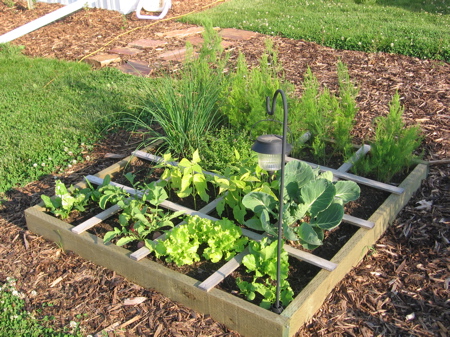 Most gardens are planted in long rows separated by three foot aisles. This means 80% of your garden (that you water, weed, and fertilize) grows nothing. You just walk on it. The square foot method eliminates that 80% of your garden that you don’t use by planting in blocks.
Most gardens are planted in long rows separated by three foot aisles. This means 80% of your garden (that you water, weed, and fertilize) grows nothing. You just walk on it. The square foot method eliminates that 80% of your garden that you don’t use by planting in blocks.
Using the square foot gardening method, you divide a 4′ x 4′ box into sixteen 1 foot square gardens. You then can plant a different crop in each of the squares. For example, you might plant 16 carrots in one box, four beans in another, and one cabbage in another. That leaves you with 13 other boxes to fill! I think it’s a fantastic system, but I’ll let you decide for yourself. Here are some of the reasons why I love square foot gardening.
#1. Perfect Dirt
It doesn’t matter what kind of soil you have, because you won’t be using it. Acidic or alkaline – it doesn’t matter. Rocky or sandy – it makes no difference. You build your own perfect soil. And it’s all really rather simple. It requires just three ingredients.
- Peat Moss
- Compost
- Vermiculite
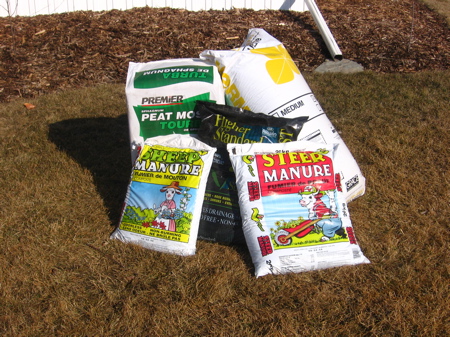 Just mix these three ingredients in equal proportions and you have the finest soil you could imagine. It’s light and loose (thanks to the peat moss), it retains moisture very well (thanks to the vermiculite), and is full of the nutrients your plants need (thanks to the compost). And all these ingredients can be found at you local garden center.
Just mix these three ingredients in equal proportions and you have the finest soil you could imagine. It’s light and loose (thanks to the peat moss), it retains moisture very well (thanks to the vermiculite), and is full of the nutrients your plants need (thanks to the compost). And all these ingredients can be found at you local garden center.
#2. No Weeding
Yup, that’s right. Since you’re making your own soil, there will be no weed seeds in there to start with. Plus, any weed seeds that might happen to blow in are easily removed because the soil is so light and loose. I think I might have pulled out five weeds from my garden last year.
#3. Less Space Required
Your square foot garden takes up only 20% of the space required by a traditional garden. That means you can be more productive with the space you have. It also means you only need to do 20% of the work.
#4. Inexpensive
I just built two square foot gardens this spring and here were my costs:
- Lumber: Free (I used scrap)
- Vermiculite: $20
- Peat Moss: $8
- Compost: $20
Total: $48 for two – $24 each.
Of course with your own lumber and your own compost, you could cut that cost down to $14 each. And once your initial garden is set up, you only need to add a little compost each year. You’ll never again need fertilizer or weed killers.
Convinced yet? Ready to build your own? Here’s how!
Required Materials
- (4) 4′ 2 x 6 boards
- (6) lattice strips (I ripped 1/4 inch thick strips off a 2 x 6)
- (8) 4″ nails or screws
- (12) 1″ nails or screws
- Cardboard, newspaper, or landscape fabric for weed control
- 60 litres of vermiculite (preferably coarse)
- 60 litres of peat moss (about 2 cubic feet compressed)
- 60 litres of compost (at least three different types – I used steer manure, sheep manure, and mushroom compost)
Building the Square Foot Garden
Attach your 2 x 6 boards together with nails or screws to form a four foot square box.
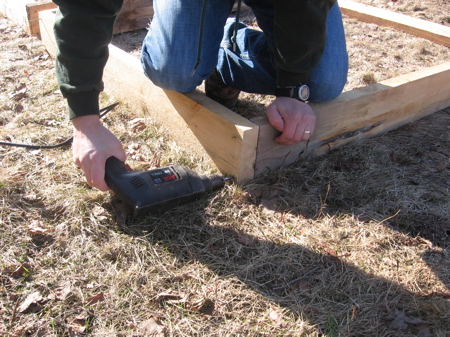
Lay down your newspaper, cardboard, or landscape fabric on the ground where you wish to place your gardens. This will prevent existing grass or weeds from pushing up into your garden. Lay your box on top of the newspaper, cardboard, or landscape fabric.
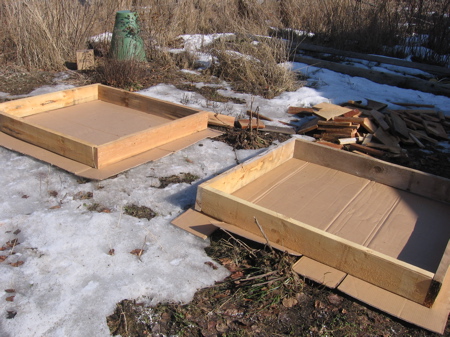
Mix the compost, peat moss, and vermiculite together in equal portions. An easy way to do this is to pile the ingredients on a large tarp and roll them back and forth in the tarp. Then carry the tarp to your garden and pour it in. (Note: You may want to water down the ingredients as they are rather dusty when dry.)
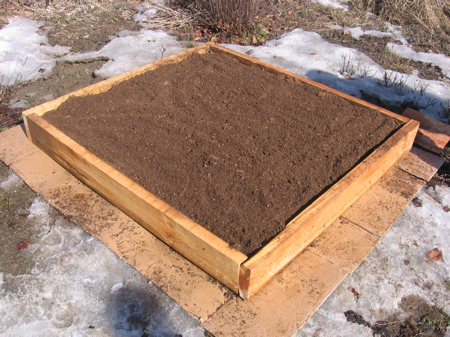
Once the soil has filled the box to the top, place the lattice on top, nailing each piece of lattice in place so that there are sixteen equal squares.
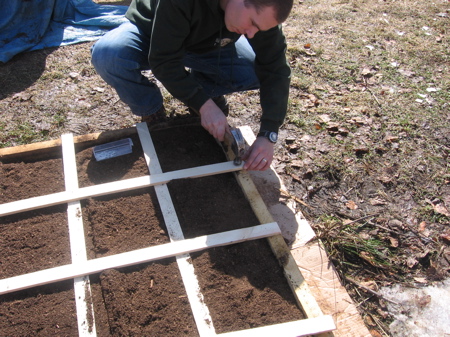
And there you have it. You’re ready to plant!
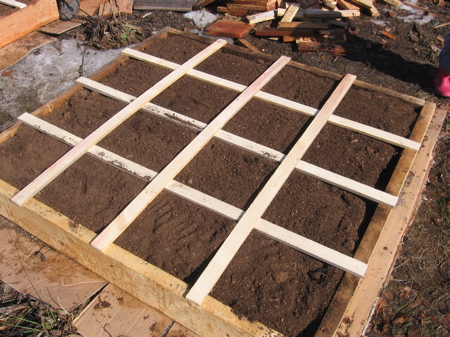
Pretty simple, isn’t it? If you’ve got any questions about how to make your own square foot garden, ask away!
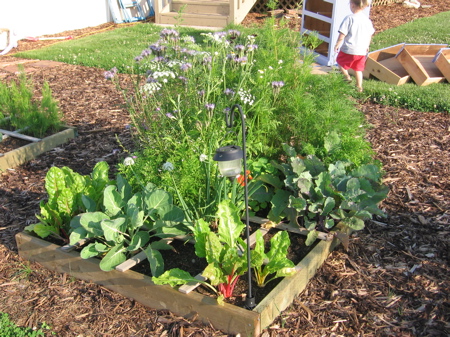
Updated: March 15, 2012
189 replies on “How to Make a Square Foot Garden”
GREAT SITE! My garden is on its way. Still getting things together. Started seeds last night though! 🙂
Hello, was wondering if you needed to use any tools to take care of your garden once you did it. Or maybe because it’s a square foot garden, with loose soil, you need less gardening tools than with a regular garden?
Olivier: You certainly can go tool-free in a squarefoot garden, but to work things up in the spring or fall, I just use a little hand-held garden spade.
This is a really good idea and something similar to what we did when we bought our house years ago. So some advice: you can’t grow root vegetables obviously, because there is a limit to the depth of the soil. And, weeds will infiltrate at some point – whether it be from the thistles in the green strip behind your house or the parsley and strawberries that reseeded themselves. Another good idea is found at http://www.digginfood.com/2010/08/gutter-gardens/ We haven’t tried that yet but have plans for next year!
I am impressed by your noticing the ditches in BC. I lived in bc for years and always admired the highway ditches. Do you know the name of the weed that is tall and various coloring…lots of blooms on the top of a very tall thick stem. I thought they were called Lupins or something to that effect, and would they grow in Alberta (calgary) climate? Thanks for your help.
Sincerely
Christine: I don’t know for sure if the plant you are thinking of is lupins, but it sounds like an accurate description. And yes, lupins certainly will grow in Alberta!
Could be purple loosestrife, a noxious weed. Also blazing star (spicata) which is a better choice than loosestrife for planting. Also foxglove grows tall in the ditches. And yes, it could also be lupins.
Does this type of garden lend itself better to certain vegetables, fruit-veggies or herbs, or would any kind work?
Eric: Most anything will grow in a SFG! Of course, root veggies like carrots or potatoes would do much better if you make them deeper (maybe 12 – 18 inches). My mother-in-law grows all her carrots in a 12inch deep SFG.
Just starting a SFG this spring, do you have any ideas to keep deer from grazing. Are the garden boxes good for full sun areas? Do you have to water more often than a garden in the ground? Excited to start this project.
Lynn: To keep the deer from grazing your SFG, you can cover it with a mesh of some sort (like the mesh that farmers use to wrap the large round bales – if you can find a farmer who is willing to share a bit) or there is some meshes in the gardening section of Peavy Mart or the like. As to full sun – it all depends on what you plant! And to for watering, I’ve found that here in Alberta, (droughts notwithstanding) I don’t need to give SFGs any special attention.
Hey Dave,
Excellent info. I was curious as to what your experience on the debate-able subject of Vermiculite is? Do you consider it safe/organic to use? I would appreciate your insight.
Nathan: I have no problem with vermiculite. It’s a natural mineral – as organic as dirt itself! In the past, some vermiculite was sold containing asbestos (not the best stuff in the world), but today vermiculite mines are tested for that, so I have no health concerns with vermiculite and would consider it safe/organic to use.
What is the volume of each product that you will need for each square?
Danny: If I understand your question correctly, you would need about 3.75 litres of each vermiculite, compost, and peat moss per square. (60 liters each for the entire 4×4 grid.)
How do you know how many seeds of each type of vegetable to plant in each square foot? We’ve built two 4×8 boxes, and I’m trying to convince my husband to try SFG in at least part of them this season. Do peas do well this way, or are they best left in rows?
Amanda: Plant larger plants one per square, medium plants four per square (2×2), smaller plantes 9 per square (3×3), and smallest plants 16 per square (4×4). Pea can grow just fine in SFG, but will need support. I like a LOT of peas and so I grow mine in several long rows. Things like carrots, onions, radish, lettuce and the like are best in SFGs.
From the picture you used a mixture of sheep manure, steer manure and something else I can’t see for your compost. Any insight on what is best to use for compost. I was thinking I might see if the local greenhouse has some. Also, the vermiculite. I was only able to find one store in the area that has it and it was super expensive ($12 for 20L) and I’m trying to fill 3 boxes measuring 2ftx4ft and 12 inches deep.
Amy: My third type of manure I believe was shrimp compost. As for what is the best… Lots of variety! (And yes, that vermiculite isn’t too cheap!)
Check Peavy Mart for Vermiculite. I’ve found it to be the cheapest there for a large bag.
You shouldn’t use pressure treated lumber for your garden it can leach harmfull chemicals into your food. I would suggest ceder natual bug repent and lastes years longer then other untreated hardwoods.
anyone know where to buy vermiculite in Edmonton? Im having trouble locating it…
holes greenhouse in st Albert has big bags of it and for the best price around the city.
Check Peavy Mart for Vermiculite. I’ve found it to be the cheapest there for a large bag.
We’re building a sf garden too. So excited to go out on my deck and pick fresh veggies. I had a question about planting…do you just put one small plant in each square? I got a six pack of peppers, and it says to plant them 12″ apart. That basically will take up more than half of my box.
Jennifer: Yes, peppers do grow into pretty large plants – you should planted just one per square.
For those in Edmonton area, the Enjoy center sells 110 L bags of vermiculite for $25 (behind the check out). Don’t spend your cash on the tiny boxes in the indoor flower sections!
Hi
We are going to build.a SF garden as well can I plant potatoes in it or should I plant them separate ?
Marg: If you have space, I’d recommend planting them elsewhere – just because they take up so much room. But if not, sure – plant them in your SFGs. Just make sure your soil is at least 8″ deep.
Message Body:
A different ‘take’ on the square foot garden. The ‘deep’ in deep bed gardening means ‘width’. On a plot of land dig beds 4ft wide by 10ft/8ft long, leaving paths about 2ft wide between the beds. You then sow in rows across the 4ft width, this will give you enough harvest for 1 to 2 people. The idea is to not walk on the beds but ‘garden’ from the paths,with a hand trowel/fork. Even on your knees you cal reach into the middle of the bed(2ft). you then shuffle along the side of the bed on your knees to continue gardening. 10ft/8ft length is the best as any longer you tend to walk across the bed as a ‘short-cut’ to the other side. You can space the plants slightly closer(so the leaves just touch each other) means you get more produce from a small space. At the sides of your plot against a fence etc. make the beds 2ft wide(so you can get to the back of the bed) and the length of the fence. I hope you understand all this. As you are sowing only 4ft rows you then sow another row of the sam
e
plant further down the row about 2/3 weeks later. A little tip – instead of planting normal beetroot 4 inches apart and then thinning them to 1 plant per station plant them 6 inches apart but let them grow until they are nearly golf ball size then carefully thin them to 1 plant and you then have ‘baby beets’ to eat followed later by normal size ‘beets’ from the same row. 2 for 1!
Apache Seeds in Edmonton also sells large bags of vermiculite. Same price as Holes.
I’m on my 3rd year of SFG and am thrilled. Every year gets better too.
Kathy, I am head of garden group in Leduc. Looking for speaker in April to talk about SFG. Would you consider it? Know anyone?
Hi Angie, My apologies for not replying! I just checked this post today for the first time since posting. I would be happy to talk to your group,except I am unable to do so this spring. I am building a new greenhouse and taking a Permaculture course this spring as well as getting my yard done. I used to work at a tree Nursery so my spring seasons were incredibly busy, I left that job so this year I will have more time to document and photograph my garden. If you are still looking for someone and would like me for the fall or next spring I could do that for you. I can be reached at kathybrown(at)xplornet.com Thanks!
Help! i know its the end of the season and unfortunately my sf gardens were a total loss. Out of the three that i planted i have two (2) tomatoes. everything else died almost as soon as it came up, and everything was stunted, teeny weeny pumpkin plants, barely there carrots. It was heart breaking. Any ideas why? this isnt my first garden and i’ve never experienced such horrid luck. What did/didn’t I do? any ideas
I have enjoyed reading all this information and am switching to SFG but am having no luck finding the course vermiculite in the Lethbridge area. Suggestions, anyone?
Any luck finding vermiculite in Lethbridge??
About to put our first square foot garden in this year! We are very excited. We are a little nervous about the vermiculite though. Not familiar with it at all. There was some health concerns mentioned on the health canada website about the dust, and to be sure it doesnt come into the home. I have two little ones that will be out in the garden with me…3 and 5. The little one will not keep gloves on and usually ends up covered in dirt. I’m concerned about the health risks associated with vermiculite. Any thoughts?. Possible substitutions for it?. Sand perhaps?. Thanks!
Amanda: The health concerns with vermiculite comes from vermiculite that was mined from a certain mine prior to 1990. The vermiculite that came from that mine was contaminated with asbestos. However, that mine has been shut down for over 20 years, and any new vermiculite purchased today will be harmless. I too, have kids – four of ’em – that love playing in the dirt and I have no concerns! If you still feel uncomfortable, you could use perilite. It doesn’t hold the water like vermiculite does, but many people substitute it.
why use vermiculite? your missing out use bio-char.mcroberts fire wood sells treated bio-char all natural product
I had a square foot garden in my last house and loved it the only problem I had was the weed paper I used only lasted a couple of seasons and then I started to have a real problem with grasses growing through. I noticed that you used cardboard. How long did it last for you and did you attach it to your boxes? What other thing would you suggest as a ground cover?
Jennifer: The cardboard was only intended to last the first season. The idea was that it would kill all the grass underneath. My guess is that the grass you have growing up is creeping in from the edges? I have mine surrounded by mulch, so I don’t have issue with grass creeping in. If that is your situation, you would want to use a thick landscape fabric underneath it all – and wrap it up around the outside of your box by about a 1/2 inch (so it stays hidden) and then staple it in place.
I am trying to set up my first SFG. I am having a very hard time finding Vermiculite. I live close to Dawson Creek, BC. The only think that I could find was “Grace Expanded Vermiculite” There are hazardous warnings all over the bag. It is expanded #3. Warnings to wear a respirator, use in a ventilated area and wear safety glasses. With a big keep out of reach of children warning.
It also says it can cause lung disease including cancer.
Do I have the wrong stuff? Is it really okay to grow food in this stuff? Is there something else I could use? I tried to copy a picture of the bag into this post but couldn’t.
Thanks
great post! We made raised bed planters a couple of years ago and have really enjoyed them. I’ve been thinking about trying square foot gardening style in them this year. looking forward to it
I’ve just learned about SFG and I’m excited – but I’m also too late for spring planting for this year. I’ve seen some sites talk about fall gardens with different plants – any advice or tips?
I live in Calgary.
Kristin: There is always SOMETHING you can grow. Radish (for example) only take a few weeks. Even at this point in the year, you could probably plant things that take 50-70 days to maturity.
I have a, possibly, really stupid question! I have my box ready to fill and need to go buy the “Mel’s Mix” stuff but I’m calculating that I need 300 L to fill it. Everything I’m reading says it doesn’t take much and is really cheap… but I’m getting that it’ll be like $300 for all those bags. I’m going for a 4’x4′ 6″ deep garden. Where am I going wrong??!
Sorry you can disregard my previous message as I read through the comments after posting (an annoying habit of mine!) and I saw that you answered someone else with 60 L each product for a 4 x 4… I’m still confused though (my math sucks!)
Hi everyone! I’m looking for the mix to fill my first garden in calgary and not having much luck. Any tips for a newbie?
Hi Kristen,
I’m looking at doing two of these beds, and was wondering how you made out that year. Any insight?
Hi there hopefully somebody can help me.I would like to start sfg next year, but the cheapest big bags of vermiculite I can find are 33 dollars. Anybody knows wher I can buy it cheaper. I live in southern alberta
If you have a Peavy Mart in your area, vermiculite is the cheapest there. $20 for the big bag.
Has anyone found the large bags of Vermiculite in Calgary recently? North Calgary preferably.
We are located in Calgary and doing our first SFG this year. I called every gardening place on Google. The following places sell the 110L / 4 cubic foot bags.
Cobblestone – $54.99
Incredigrow – $55
Garden Retreat – $40
Professional Gardner – $33.95 – we are going with them as its in Inglewood and closer to home.
Peavey Mart sells it but only has fine grind in stock. It was way cheaper so if we add more boxes next year I’ll look into them again, although they are only in High River or Strathmore.
Vermiculite in Calgary Update! We picked up the 4 cubic foot bags of course vermiculite from Professional Gardener. The owner was great. I called Saturday afternoon and they were closed but he was at the warehouse so he let us come by. It turned out they have a lot of stock and there were some ripped bags which he couldn’t ship on a truck, so he sold them to us for $20 each. I highly recommend them.
http://www.theprofessionalgardenercom.com/head-office.html